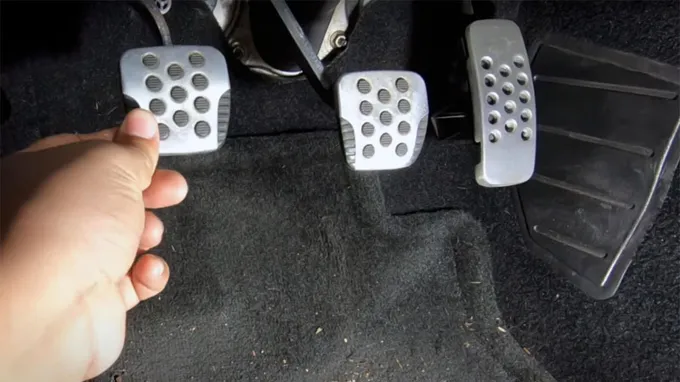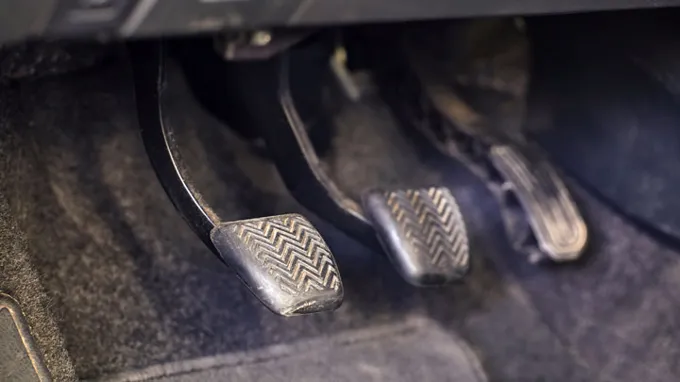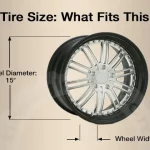If you’ve spent any time driving a manual transmission car, the clutch pedal should be a familiar part of the vehicle’s interior. But do you really know what a clutch pedal is? The clutch pedal is an essential component of a manual transmission car. It works in conjunction with the clutch disc, flywheel, and pressure plate to engage and disengage the engine from the transmission.
Essentially, the clutch pedal is responsible for allowing you to smoothly shift gears while driving. It’s a small but mighty part of your car that requires a bit of coordination to use effectively. Let’s dive in and learn more about this critical part of your vehicle’s drivetrain.
Table of Contents
Basics of Clutch Pedals
A clutch pedal is an essential part of a manual transmission vehicle. It’s the foot-operated pedal positioned on the left side of the brake pedal. When you press the clutch pedal with your foot, it temporarily disengages the engine from the gearbox, allowing the driver to shift gears smoothly.
Without the clutch pedal, it would be impossible to change gears in a manual transmission car. To use it, you need to depress the clutch pedal all the way to the floor while simultaneously shifting the gear knob. Releasing the clutch pedal slowly and steadily will engage the engine to the gearbox in the corresponding gear.
To make driving a manual car straightforward, familiarising yourself with the proper way to operate the clutch pedal is crucial.
Definition
A clutch pedal is a component of the manual transmission system in a vehicle. It is operated by the driver to engage and disengage the clutch mechanism. When the clutch pedal is depressed, the clutch disengages and separates the engine’s power from the transmission system, allowing the driver to shift gears.
The clutch pedal is essential in controlling the speed of the vehicle since the driver must press and release the pedal to change the transmission’s gear. It requires skill and experience to operate a clutch pedal, as it can cause the car to stall if not used correctly. The clutch pedal is vital in providing a smooth ride by enabling the driver to shift gears smoothly without jerking or lurching.
In summary, the clutch pedal is a crucial component of a manual transmission vehicle that helps the driver to control the engine’s power and maintain a smooth ride.

Functionality
When it comes to driving manual transmission cars, one of the most crucial components is the clutch pedal. The clutch pedal allows you to disengage the engine from the gears, making it possible to shift gears smoothly and efficiently. Basically, the clutch pedal is the intermediary between the engine and the transmission.
When you press the clutch pedal down, the clutch disc is disengaged, and as you release the pedal, the clutch disc engages once again. It’s important to note that the clutch pedal isn’t just a simple on-off switch; the amount of pressure you apply to the pedal affects how much power is transferred between the engine and the transmission. Mastering the clutch pedal is crucial for anyone who wants to drive a manual transmission car effectively.
Location
Location Are you familiar with clutch pedals? These pedals are located in manual transmission vehicles and are responsible for connecting the engine to the transmission. They allow the driver to switch gears and control the speed of the car. Clutch pedals are typically located on the left side of the brake pedal.
In some vehicles, they may be closer together, while in others, they may be further apart. It’s important to familiarize yourself with the location of the clutch pedal in your vehicle to ensure smooth and safe driving. So next time you get behind the wheel of a manual car, take a moment to locate the clutch pedal, so you can focus on the road ahead.
How Clutch Pedals Work
If you’re learning to drive, you may hear a lot about clutch pedals. But what exactly is a clutch pedal? Well, it’s a crucial component of vehicles with manual transmissions that allows you to switch between gears smoothly. Essentially, the clutch pedal is responsible for disengaging and engaging the engine from the transmission.
When you press down on the pedal, it disengages the engine, allowing you to transition between gears. Then, when you release the pedal, the engine engages again, and the transmission goes into gear. Think of it like a light switch: pressing the pedal turns off the engine’s power to the transmission, while releasing the pedal turns it back on.
Learning to use the clutch pedal properly takes practice, but getting the hang of it will make you a much more confident and capable driver.
Mechanism
Clutch pedals are essential components of manual transmission vehicles and play a crucial role in the smooth operation of shifting gears. When the clutch pedal is pressed, it engages the clutch, separating the engine from the wheels and allowing the driver to change gears. The clutch pedal works by connecting to the clutch cable, which then pulls the clutch release fork.
The fork, in turn, puts pressure on the clutch diaphragm spring, causing it to compress and release the clutch. The clutch pedal acts as a lever, providing a mechanical advantage that makes it easier to press the pedal down with your foot. Proper modulation of the clutch pedal is essential to ensure smooth shifting and prevent premature clutch wear.
With practice and skill, a driver can master the operation of clutch pedals and enjoy the full performance of a manual transmission vehicle.
Engagement and Disengagement
When we think of clutch pedals, we often associate them with manual transmission cars. But how do they actually work? The clutch pedal is responsible for engaging and disengaging the engine from the transmission, allowing you to shift gears smoothly. When the clutch pedal is pressed down, it disengages the engine and transmission, which means that the engine can still run without the wheels moving.
This is known as disengagement. When the clutch pedal is released, the engine and transmission are re-engaged, and the wheels begin to move. This is known as engagement.
The clutch pedal is a crucial component for manual cars, as it allows you to control the speed and acceleration of the vehicle. Without it, the car would not be able to function properly. So, the next time you shift gears in a manual transmission car, remember the importance of the clutch pedal in making that possible.
Manual vs. Automatic Transmissions
If you’re new to driving, you might be wondering what exactly a clutch pedal is and how it relates to the difference between manual and automatic transmissions. Put simply, a clutch pedal is found exclusively on vehicles with a manual transmission. It’s used to disengage the engine from the transmission so that you can change gears.
When you press down on the clutch pedal, it releases the pressure plate, which in turn releases the clutch disk. This disengages the engine from the transmission, providing the momentary disconnection needed to switch gears. Once you shift gears, you release the clutch pedal to re-engage the engine with the transmission.
Automatic transmissions, on the other hand, don’t require a clutch pedal at all – the transmission automatically shifts gears without any input from the driver. While some drivers prefer the control a manual transmission and clutch pedal provide, others appreciate the ease-of-use and convenience of an automatic transmission.
Differences
When it comes to driving a vehicle, there are a lot of decisions to make. One of the most important decisions is whether to go with a manual or automatic transmission. Manual transmissions require the driver to move through the gears themselves, while automatic transmissions handle the shifting for you.
There are pros and cons to both options, and the right choice for you will depend on your personal preferences. Manual transmissions tend to offer more control and better fuel efficiency, but can be more difficult to drive in heavy traffic. Meanwhile, automatic transmissions are easier to use and can handle heavy traffic more smoothly, but can be less fuel efficient and can also be more expensive to repair if something goes wrong.
Ultimately, both types of transmissions have their advantages and disadvantages, so it’s important to weigh your options and choose which one is right for your driving needs.
Uses
When it comes to driving, one of the most significant decisions you’ll need to make is whether to go for a manual or an automatic transmission. Both types of transmission have their pros and cons, and the one you choose will depend on your preferences and driving style. Manual transmissions provide more control over the vehicle, allowing drivers to enjoy a more engaging and responsive driving experience.
However, they require more skill to operate and can be challenging in heavy traffic or on steep hills. On the other hand, automatic transmissions are more straightforward to operate and are ideal for drivers who prefer a more relaxed driving experience. They also tend to be more fuel-efficient than manual transmissions, making them a popular choice for commuters.
Ultimately, it’s up to you to decide which type of transmission is best for your driving needs and preferences.
Conclusion
In summary, a clutch pedal is the ultimate wingman of your car’s transmission, providing the smooth and precise shifting necessary to navigate the roads with style and finesse. It’s the unsung hero behind every seamless gear change, allowing you to effortlessly shift gears like a pro. So the next time you’re cruising down the highway, give your clutch pedal a nod of appreciation – after all, it’s the one that’s got your back, no matter where the road takes you.
“
FAQs
What is a clutch pedal used for in a manual transmission vehicle?
The clutch pedal is used to engage and disengage the clutch, allowing the driver to change gears manually.
How does a clutch pedal work?
When the clutch pedal is pressed, it disengages the clutch, separating the engine from the transmission to allow for gear changes. Releasing the pedal re-engages the clutch.
Can a clutch pedal feel different in different vehicles?
Yes, the feel of a clutch pedal can vary based on the make and model of the vehicle, as well as the age and condition of the clutch itself.
Is it difficult to learn to use a clutch pedal?
Learning to use a clutch pedal takes practice and patience, but it is a skill that can be mastered.
What are some common problems that can occur with a clutch pedal?
Common issues with a clutch pedal include slipping, grinding, and failure to engage. These problems can be caused by a worn clutch or other mechanical issues.
Can a clutch pedal be replaced?
Yes, a clutch pedal can be replaced if it becomes worn or damaged. This is a complex repair that should be performed by a professional mechanic.
What are some tips for using a clutch pedal effectively?
To use a clutch pedal effectively, it is important to practice smooth and gradual movements, and to avoid riding the clutch or shifting too quickly. Additionally, maintaining proper clutch and transmission fluid levels can help to prolong the life of the clutch.



